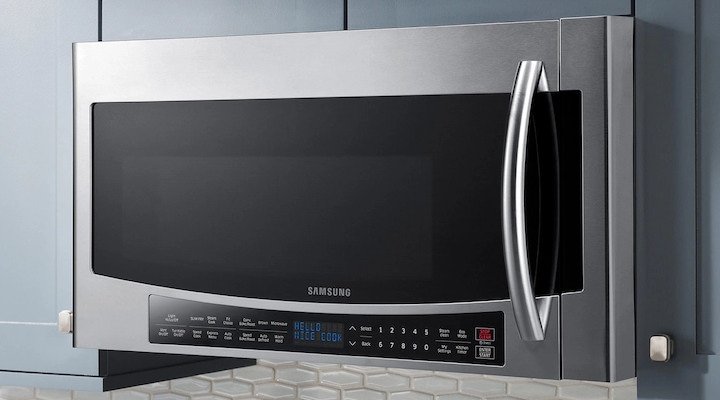
Error codes, in simple terms, are like text messages from your appliances. They’re trying to tell you something is off, but it’s up to us to interpret their cryptic language. The “F2” error on a Samsung microwave specifically suggests there’s a problem with the temperature sensor. Think of this sensor as your microwave’s internal thermometer. It’s crucial for maintaining the right cooking environment, so when it malfunctions, your microwave can’t accurately heat your food. Left unchecked, this issue could lead – at best – to unevenly cooked meals, and at worst, to potential hazards.
Understanding Error Code F2
The error code F2 that pops up on your Samsung microwave isn’t there just to annoy you. It’s a safety mechanism designed to alert you that the temperature sensor is having issues. This sensor is a tiny component deep inside your microwave, responsible for monitoring and controlling the temperature. Imagine trying to bake a cake without knowing how hot your oven is – it’s a recipe for disaster. Similarly, if your microwave’s temperature sensor isn’t working properly, it can lead to cooking mishaps.
So how does this error manifest? Well, when the temperature sensor fails, your microwave can’t determine the correct temperature. This can cause the appliance to overheat or underheat your food. If left unresolved, it may also lead to further complications such as short circuits or damage to other internal components. The idea is similar to driving a car when the check engine light is on – it’s not advisable and can worsen the problem over time.
You might be tempted to ignore the error and continue using your microwave, but it’s important to address it. Continuing to use a malfunctioning appliance can exacerbate the issue and even pose a safety risk. Therefore, understanding and addressing the F2 error is not just about ensuring your meals are properly cooked; it’s also about maintaining the safety and longevity of your microwave.
Causes of the F2 Error
Now, you might be wondering, “What causes the F2 error in the first place?” Generally, there are a few common reasons. First and foremost is a faulty temperature sensor. Just like a misbehaving thermostat in a home, if the sensor isn’t functioning correctly, it can lead to inaccurate temperature readings and trigger the error code.
Another potential cause is poor electrical connections. If there’s a loose wire or an unreliable connection within the microwave, it might lead to erratic functioning. Imagine trying to watch your favorite TV show only to have the screen go blank because of a loose cable – frustrating, right? The same principle applies here. Finally, internal damage due to wear and tear over time can also lead to this error. Like a pair of well-loved shoes, eventually, parts of your microwave may degrade with use.
What should you do if you identify one of these causes? Start by ensuring any loose wires are secured and check the sensor for obvious signs of damage or wear. However, if you’re not comfortable fiddling around inside your microwave, it’s always best to call in a professional. Let’s face it, fiddling with complex electronics isn’t everyone’s cup of tea, and that’s okay!
Resolving the Error
So, you’ve identified the F2 error and what’s causing it. The burning question remains: how do you resolve it? The answer may vary depending on the root cause, but there are some general steps you can take. If the error is due to a faulty temperature sensor, it might need to be replaced. Replacing these components can feel daunting, but with the right tools, it can be a straightforward DIY task. However, if DIY isn’t your style, seeking a professional’s help is never a bad idea.
For loose or damaged connections, ensure all wires are firmly in place and not exhibiting any signs of damage. Think of it like tightening a leaky faucet – a little adjustment can prevent future drips. If you notice significant wear and tear on internal components, it might be time to consider replacing the microwave. Evaluating repair costs versus investing in a new microwave is crucial for long-term satisfaction.
Lastly, whether you fix it yourself or call a professional, always test your microwave after attempting repairs. Try microwaving a cup of water, and watch if the error reappears. If it does, it’s best to consult a professional to avoid any potential hazards.
Preventing Future Errors
Who wouldn’t want to avoid error codes altogether in the future? While some issues are unavoidable, regular maintenance can minimize the likelihood of encountering the F2 error again. Much like getting your car serviced or regularly flossing your teeth, consistent care can prevent bigger problems down the road.
For starters, keep your microwave clean and free from food splatters, as these can interfere with sensors and other components. Ensure the vents are not blocked, allowing proper airflow and preventing overheating. Regularly check the condition of the power cord and internal parts if accessible, and don’t shy away from professional check-ups once in a while.
Additionally, using the microwave as intended and not overloading it with heavy or unsuitable items can prolong its life. Following manufacturer guidelines can be a guiding star in maintaining your appliance. It’s all about creating good habits that will extend the life of your microwave.
In conclusion, while encountering an F2 error on your Samsung microwave can be frustrating, understanding its implications and taking the right steps can ensure your appliance remains a safe and useful kitchen companion. By being proactive and attentive, you can minimize the impact of such issues and enjoy your meals without any hiccups.